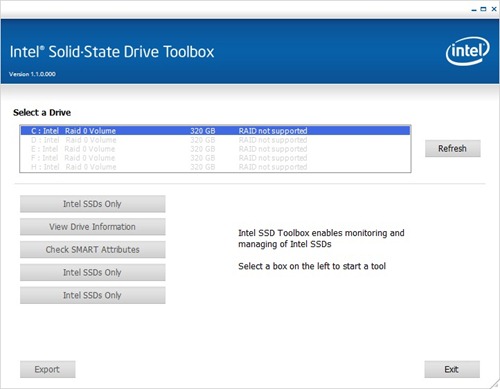An SSD or Solid-State Drive is a replacement to the traditional hard disk drive with the advantage of better performance, lower power consumption and higher reliability. People who own Intel SSDs now have to way to manage and retain the out-of-box performance of their SSDs with the Intel SSD Toolbox.
The Intel SSD Toolbox allows users to effectively monitor and manage the health of their SSDs. The toolbox with Intel SSD Optimizer and firmware update uses the Windows 7 ATA Data Set Management Command (known as Trim) to help keep the Intel SSD running at continued high performance. In addition, the SSD Toolbox and Optimizer also allow these enhancements to work with Windows XP and Vista operating systems.

The Intel SSD Toolbox provides SSD management tools and information about the drive, including comparing Self-Monitoring and Reporting Technology (S.M.A.R.T.) drive attributes to manufacturer threshold. It provides basic and full diagnostics, along with recommended actions. The Toolbox also features an easy-to-use graphical user interface that will allow end users to schedule and run the Trim command independent of the operating system. The company recommends users install the firmware update and toolbox, and run the Trim function daily to ensure best performance.
For 34nm X25-M 160GB owners, the firmware update also offers a performance boost to sequential write speeds by delivering up to 100MB per second, a 40 percent performance improvement over the existing firmware version.
The Trim attribute of the ATA Data Set Management Command synchs the operating system's view of deleted files with those that are deleted, but not erased on the drive. Trim tells the SSD which data blocks are no longer in use which helps stabilize the performance and health of the SSD over time.
The Intel SSD Toolbox feature highlights
- Accessing Intel SSD management features.
- Reporting the drive identification data for Intel SSDs, as well as other drives.
- Accessing the Self-Monitoring, Analysis, and Reporting Technology (SMART)
attributes for Intel SSDs, as well as other drives.
- Checking the SMART thresholds and viewing recommended actions for Intel
SSDs, as well as other drives.
- Running diagnostic scans on Intel SSDs to check for any READ or WRITE
errors.

Comments
Post a Comment